January 31, 2019

A study released recently by the U.S. Department of Agriculture reporting huge gains in U.S. rice productivity proves the value of the country’s investment in agricultural research and science, said Dr. Chavonda Jacobs-Young, USDA Acting Deputy Under Secretary for Research, Education, and Economics.
Jacobs-Young, who is also administrator of USDA’s Agricultural Research Service (ARS), cited a report by the Economic Research Service (ERS) entitled: “U.S. Rice Production in the New Millennium: Changes in Structure, Practices, and Costs.”
“The adoption of innovations such as herbicide-tolerant rice varieties and precision farming practices have contributed to a production boom in rice that is good news for producers, good news for consumers, and good news for exporters,” she said. “Research supported by both the private sector and by USDA have been instrumental in making these innovations a reality,” she said.
The report specifically credited the new rice varieties and precision farming with helping to increase U.S. rice productivity by 29 percent between the years 2000 and 2013, as well as increase per-acre yields by more than 100 percent in that same period. In addition to increased production, the result has been lower-than-expected prices, which ERS found have benefitted both consumers and exporters of U.S. rice.
“The report also found that future gains in domestic rice productivity are possible through the continued adoption of these technologies and practices,” Jacobs-Young said. “Clearly, continued agricultural research is a key to maximizing the ability of American producers to prosper by feeding the world.”
Earlier this year, scientists at Louisiana State University introduced a new herbicide-resistant line of rice called Provisia, which will complement existing lines of herbicide-resistant rice and help extend the life of both lines. Research to develop the Provisia line was supported by grants from USDA’s National Institute of Food and Agriculture (NIFA). Likewise, both NIFA and USDA’s Agricultural Research Service have supported extensive research in the area of precision agriculture practices.
Source: USDA, which is solely responsible for the information provided and is wholly owned by the source. Informa Business Media and all its subsidiaries are not responsible for any of the content contained in this information asset.
You May Also Like




